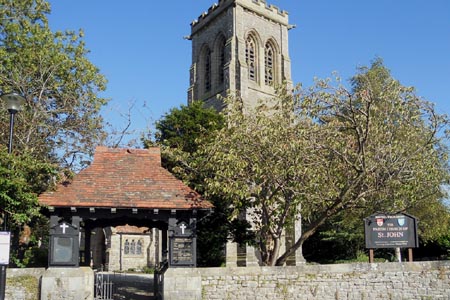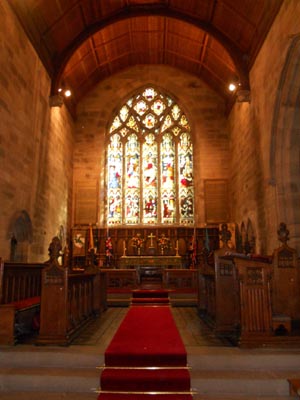| |
 |
 |
 |
| Comment on this report, or find other reports. |
 |
| Our Mystery Worshippers are volunteers who warm church pews for us around the world. If you'd like to become a Mystery Worshipper, start here. |
 |
| Find out how to reproduce this report in your church magazine or website. |
|
|
| 2225: St John's,
Silverdale, Lancashire, England |
 |
 |
 |
Mystery
Worshipper: Chris Teean.
The church:
St
John's, Silverdale, Lancashire, England.
Denomination:
Church
of England, Diocese
of Blackburn.
The building:
St John's is a small neatly built church with a square tower
and a lych gate, and its picture postcard appearance must make
it very popular as a venue for weddings. Designed by the architect
William Bell in the style of earlier times, it was consecrated
in 1886, and replaced an older building that dated back to the
12th century. The conventional interior consists of a nave with
one central and two side aisles, and a rather beautiful chancel
with carved choir stalls. There is an impressive east window
with five lights depicting scenes from the life of Christ and
quotations of the beatitudes from St Matthew. The communion
table, complete with a brass cross, candles and floral decorations,
has a representation of Leonardo da Vinciís Last Supper, and
the reredos is made from Danzig oak. At the west end is the
bell tower, which has a peal of six bells, and a font made out
of Caen stone.
The church:
There are two holy communion services and a service of evening
prayer every Sunday. Holy communion is also celebrated each
Wednesday and on special days throughout the year. The church
has recently celebrated its 125th anniversary, which involved
hosting an art and craft exhibition, a flower festival and a
choir concert. There is a bell ringing group, a Mothersí Union,
and various childrenís clubs.
The neighbourhood:
The pretty coastal village of Silverdale lies in an area of
outstanding natural beauty in north west Lancashire, and it
overlooks the sweeping vista of Morecambe Bay. It developed
in the mid 19th century when a railway line was built connecting
it to industrial cities. However, nowadays many people travel
north up the M6 motorway en route to the well-known delights
of the Lake District and are completely unaware of the existence
of this charming area. In the village there is a mixture of
Victorian properties, stone buildings, and modern houses and
bungalows that exude an air of prosperity, together with a few
shops, a library and two hotels. The church is on the edge of
the village with a primary school across the road as its immediate
neighbour.
The cast:
The celebrant was the Revd Canon Paul Warren, priest in charge.
The date & time:
Seventh Sunday after Trinity, 7 August 2011, 10.15am.
What was the name of the service?
Parish Eucharist.
How full was the building?
I was pleasantly surprised to find it was quite healthily attended for such a relatively quiet area and I would estimate at least 100 people were in the congregation. I would say the majority, as is often the case, were on the wrong side of 50, but I did notice a few children as well.
Did anyone welcome you personally?
A sidesperson, who handed me the books for the service, greeted
me with a cheery "Good morning." The priest also welcomed
me when it came to the exchange of peace.
Was your pew comfortable?
It must be one of the most comfortable church seats I have ever
sat on! It was a traditional wooden pew but topped with a deeply
padded cushion that was really effective. The hassock was also
a deep padded cushion that was also equally comfortable to kneel
on.
How would you describe the pre-service
atmosphere?
There was quite a lot of chattering going on as people greeted
each other. I felt a little sorry for the organist, who was
playing beautifully. His skills were obviously not being appreciated!
What were the exact opening words of the
service?
Announced by the server: "Good morning. We start our service
this morning by singing hymn number 367 ('King of glory, King
of peace')." After the hymn, the priest said: "In
the name of the Father, the Son and the Holy Spirit, Amen."
What books did the congregation use during the
service?
Hymns Ancient and Modern and a St Johnís service booklet.
What musical instruments
were played?
A two manual pipe organ by Abbott and Smith of Leeds, played
expertly by Mr John Perrin. It was such a pity there was no
choir. The July edition of the church magazine I found in my
holiday property mentioned a choir practice and a choir concert,
so a choir must exist! Perhaps they were on holiday, exhausted
after their concert.
Did anything distract
you?
At the end of the service, the priest told us he had to dash
off to another church a few miles away, at which point a gentleman
in the pew behind me quipped, "Donít get done for speeding!"
After seeing him finish off the consecrated wine in the usual
fashion, Iím afraid I had a vision of a merry vicar driving
around the local fiendishly twisty roads at great speed! On
a serious note, though, Iím sure my imagination got the better
of me!

Was the worship stiff-upper-lip,
happy clappy, or what?
In my opinion it was middle of the road style, although I believe
it is referred to as "Lancashire low." The priest
wore a green chasuble and was accompanied by two ladies in blue
gowns and a server in a white cassock. One of the ladies acted
as crucifer; one assisted at the communion table. The server
announced the hymns and they all assisted with the administration
of communion. There were no smells or bells in the service.
The two readings and the prayers of intercession were very well
read. The gospel was read, not chanted – in fact there
was no chanting at all. Overall the worship was dignified, thoughtful
and reverent.
Exactly how long was the
sermon?
10 minutes.
On a scale of 1-10, how good was the preacher?
8 – Canon Warren spoke clearly, although rather fast. He
made some jokes, and managed to wag his finger gently at his
congregation.
In a nutshell, what was the sermon
about?
The main theme was about how to use silence effectively in our
worship of God. It was in the stillness after the storm that
Elijah found God. Jesus prayed on his own in silence. But we
are often afraid of silence, even though we need it. The church
is kept open in the day so that people can come in for silent
prayer. We ought to be silent before a service, as was the practice
until recent times. (This is where Canon Warren wagged his finger!)
The early Christians were buffeted by storms of persecution
and they needed the presence of Jesus in their hearts to give
them calmness and courage and faith. Peter was able to walk
on water whilst he looked at Jesus, but as soon as he looked
down he began to sink. If we are to stay afloat in all the storms
of our life, we need our eyes fixed in faith on Jesus. St Paul
said that if you confess in your heart that Jesus is Lord, you
will be saved. God will guide us and show us the right course
of action.
Which part of the service was like being in
heaven?
I was impressed with the way the congregation sang the hymns with enthusiasm and gusto; it was a lovely feeling to be in this little church and join with them in singing praises to God. They sang all the responses really well Ė much better than the mumble you often hear. And, although not part of the service, the pealing of village church bells sounding out over the countryside sent a shiver of delight down my spine.
And which part was like being in... er... the other place?
This is a difficult question to answer having just had such
a pleasant experience! I can only say that the one thing that
always niggles me is the use of modern language in our Church
of England services. I would say that 95 per cent of that congregation
had been brought up with beautiful traditional language, yet
we have had these awful modern words thrust upon us. We should
be proud of our rich liturgical heritage.
What happened when you hung around after the service looking lost?
I had a friendly chat with Canon Warren and some ladies, all
of whom wanted to know where I came from. When they found out
that I was on holiday, they were eager to recommend places to
visit. There was a general feeling of bonhomie in the air.
How would you describe the after-service
coffee?
It was hot and pleasant, and there was a good choice of biscuits.
How would you feel about making this church your regular (where 10 = ecstatic, 0 = terminal)?
8 – If I lived in this area I would definitely consider
worshipping here and would feel comfortable mixing with the
congregation. However, my preference is for a more traditional
service with rich liturgy, so although I enjoyed worshipping
in this delightful church today, I might just seek out something
a bit more up the candle in its style of worship.
Did the service make you feel glad to be a
Christian?
Very much so. I felt honoured to join this congregation in their act of worship and praise to God.
What one thing will you remember about all this in seven days' time?
From my hillside holiday property I had a wonderful view over the fields of this gem of a church, and the photographs I have taken will be very much treasured. |
|
|
 |
 |
 |
| We rely on voluntary donations to stay online. If you're a regular visitor to Ship of Fools, please consider supporting us. |
 |
 |
 |
| The Mystery Pilgrim |
 |
| One of our most seasoned reporters makes the Camino pilgrimage to Santiago de Compostela in Spain. Read here. |
 |
 |
 |
| London churches |
 |
| Read reports from 70 London churches, visited by a small army of Mystery Worshippers on one single Sunday. Read here. |
| |
|
|
|
|


